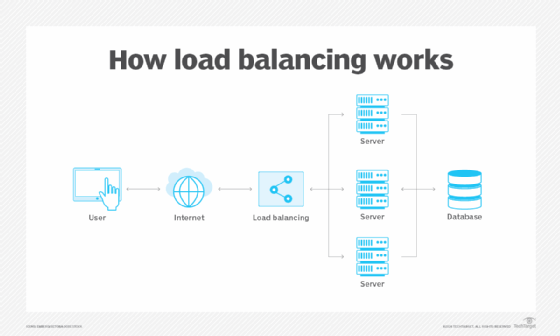
Load sharing vs. load balancing: What's the difference?
Load sharing and load balancing are two techniques that work to distribute traffic across a network. However, their methods of balancing differ significantly. Here's how.
Load sharing and load balancing both achieve the same goal of meeting application and service delivery requirements based on traffic load. When comparing how to achieve this goal from a technical perspective, however, the two methodologies are quite different.
What is load sharing?
Load sharing statically splits connection traffic and sends it to multiple processing destinations. In most cases, the sharing service identifies connections based on their source and destination IP or media access control address. Traffic then forwards across two or more paths using this information.
What is load balancing?
When a network device forwards data toward a packet's destination, which may be a cluster of distributed servers, the forwarding process includes the ability to send the data across multiple paths. This is the process of load balancing. Network devices can determine which path a particular packet or connection makes to a distributed server using a balancing method.
Some load-balancing methods include the following:
- Round robin and weighted round robin. Round robin and weighted round robin alternate between two or more connections. Weighted round robin connections send traffic down paths more likely to have high throughput and low latency.
- Least connection and weighted least connection. The load balancer dynamically monitors existing connections and attempts to equally distribute loads across multiple paths based on the fewest number of established client-server connections. Like weighted round robin, least connection load balancing also has weighted options.
- Response time. The load balancer can dynamically send data over the path with the lowest perceived network latency, based on real-time monitoring of response times to destinations.
- Agent-controlled load balancing. Destination servers that monitor current load usage can have software agents installed on them. The software agent sends information back to the load-balancer service, which then forwards traffic to the destination with the lowest server load.

When to choose one transport method over the other
Load sharing is an easier technique to set up and manage because it uses static distribution based on source or destination information contained within each packet. The dynamic nature of load balancing makes things more challenging, as traffic distributes dynamically.
Network professionals should take extra time and care to set up and continuously monitor the load, while ensuring the balancing type and weighted load-balancing settings distribute traffic as intended. That said, if load balancing is properly set up to equally balance traffic across multiple paths, it's the more efficient method.
Can load sharing and load balancing work together?
Load sharing and load balancing can coexist on the same network. It's often the case that network teams configure load sharing for some applications and services, while using load balancing for others, such as microservices. This decision largely depends on the network performance needs of the application or service and its recommended architecture.





